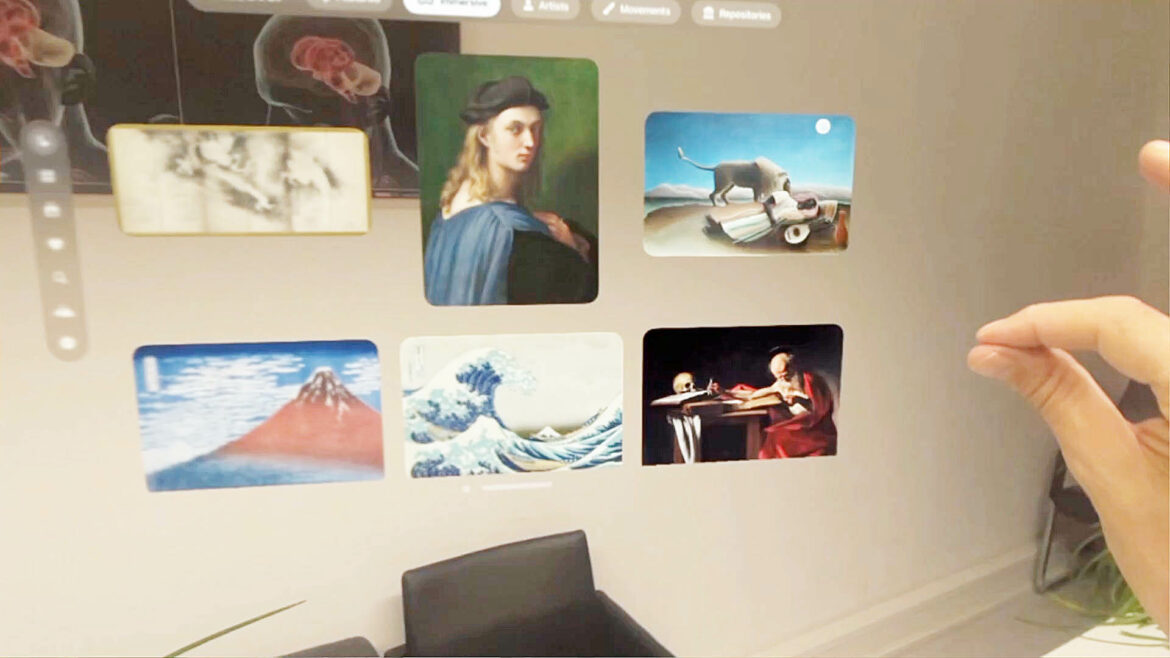Visoric develops applications using Spatial Computing for the museum sector
Photo: © Visoric GmbH | Insight into the digital transformation of the museum sector through Spatial Computing, AR, and VR.
What is “Museas: The Spatial Museum”?
“Museas: The Spatial Museum” is an innovative app for Apple Vision Pro that transforms the museum experience through the use of cutting-edge technologies. This app leverages the full spectrum of Augmented Reality (AR) and Virtual Reality (VR) to create immersive and interactive experiences that go far beyond traditional museum visits.
Main Features of the App:
Museas: The Spatial Museum offers a variety of features that revolutionize the user experience in both museum and virtual environments.
- Immersive display of exhibits: Users can explore artifacts in a three-dimensional environment, whether in physical museums or virtual spaces.
- Interactive content: Through gesture control and voice commands, visitors can interact directly with exhibits and delve deeper into the subject matter.
- Personalized experiences: Based on user behavior and preferences, the app offers customized tours and content.
- AR extension: Historical artifacts can be experienced in their original context, such as through the reconstruction of ancient buildings or landscapes.
These main features of Museas: The Spatial Museum allow users to experience history in a completely new way, offering deeper insights and personalized experiences.

Practical Example: “Museas: The Spatial Museum”: Revolutionizing the visitor experience through digital technologies.
Photo: © Visoric GmbH | The app “Museas: The Spatial Museum” demonstrates how Spatial Computing, AR, and VR are transforming the museum sector.
Benefits of Spatial Computing for the Museum Sector
The “Museas” app impressively shows how Spatial Computing has the potential to fundamentally change and enrich the museum experience. These technologies offer museums numerous benefits that can improve both the visitor experience and internal operations.
Key Benefits:
The “Museas” app demonstrates how Spatial Computing helps museums elevate their exhibitions to a new dimension and offer visitors an unparalleled experience. These benefits are crucial for the future of the museum sector.
- Deeper immersion: Visitors experience exhibits more intensely by being able to view them from different perspectives and delve into contextual information.
- Increased accessibility: The app makes museums accessible to a broader audience, including those who cannot visit in person due to distance or physical limitations.
- Personalized learning experiences: By using AI, content can be tailored to the needs and interests of users, enriching and intensifying the learning experience.
Thanks to these benefits, museums can not only increase their appeal to a wider audience but also fulfill their educational mission more effectively by providing visitors with a deeper and personalized understanding of the exhibits.

Benefits of Spatial Computing for Museum Apps
Photo: © Visoric GmbH | Spatial Computing revolutionizes the museum experience and enhances accessibility and interactivity for visitors worldwide.
Potential Benefits for Museums and Cultural Institutions
The implementation of “Museas: The Spatial Museum” offers museums and cultural institutions a variety of strategic benefits that go far beyond the visitor experience.
Strategic Benefits:
The implementation of “Museas: The Spatial Museum” opens up numerous strategic benefits for museums and cultural institutions that not only enhance the visitor experience but also promote long-term sustainability and economic stability.
- Extended reach: By digitizing their collections, museums can reach a global audience, particularly smaller institutions that may not have the resources to organize international exhibitions.
- Sustainability and preservation: Digital reproductions of exhibits help minimize the physical wear of delicate objects and ensure the long-term preservation of cultural assets.
- New revenue streams: Museums can generate additional income by selling digital experiences or subscriptions to exclusive content.
Through these benefits, museums can secure their relevance in the digital age, make their collections globally accessible, and at the same time explore new ways to preserve and monetize their cultural assets.

Practical Example: “Museas: The Spatial Museum”: Strategic Benefits for Museums and Cultural Institutions.
Photo: © Visoric GmbH | Visoric experts demonstrate how “Museas: The Spatial Museum” can revolutionize the reach, sustainability, and revenue streams of museums.
Challenges and Ethical Considerations
Despite the numerous advantages, museums face challenges when implementing these new technologies that must be considered.
Key Considerations:
The Apple Vision Pro App ‘Museas: The Spatial Museum’ represents a significant step in the digital transformation of the museum sector. This app shows how advanced technologies such as AR and VR can enhance and expand the traditional museum experience.
- Technological barriers: High costs and the need to invest in modern infrastructure can be a hurdle for some museums.
- Ethical considerations: The virtualization of cultural assets raises questions about authenticity and proper interpretation. It is crucial that digital representations are accurate and respectful.
These key features and benefits highlight the transformative potential of Spatial Computing in the museum sector. They not only offer a new dimension of interaction and accessibility but also open up new ways for cultural institutions to present their collections globally while promoting sustainable practices.

Practical Example: “Museas: The Spatial Museum”: Digital Transformation in the Museum Sector.
Photo: © Visoric GmbH | Visoric experts demonstrate how Spatial Computing and AR revolutionize the museum experience and lead cultural institutions into the digital future.
Watch the Video: Insights into ‘Museas: The Spatial Museum’ – A Model for Digital Transformation in the Museum Sector
Would you like to learn more about how Spatial Computing and AR can revolutionize the museum experience? Watch the video and send me a message to find out how we can implement this model for your cultural institution.
Video: © Visoric GmbH | “Museas: The Spatial Museum” – A Model for Digital Transformation in the Museum Sector.
Conclusion: The Future of the Museum Sector
“Museas: The Spatial Museum” shows how the museum sector can be transformed through the use of Spatial Computing and related technologies. This app opens up new possibilities for museums to present their collections in innovative ways, expand their reach, and revolutionize the visitor experience. At a time when digital experiences are becoming increasingly important, “Museas” represents a significant step towards a future-oriented, digitally supported museum sector.
Collaboration with Visoric:
- Phone: +49 89 2155 2678
- Website: visoric.com
- Email: info@visoric.com
If you are interested in how your institution can benefit from technologies like Spatial Computing, AR, VR, and AI, do not hesitate to contact us. At Visoric GmbH in Munich, we support cultural institutions in mastering digital transformation and developing customized solutions that expand your reach and delight your audience. Let us shape the future of the museum sector together.
Contact Us:
Email: info@xrstager.com
Phone: +49 89 21552678
Ansprechpartner:
Ulrich Buckenlei (Creative Director)
Mobil +49 152 53532871
Mail: ulrich.buckenlei@xrstager.com
Nataliya Daniltseva (Projekt Manager)
Mobil + 49 176 72805705
Mail: nataliya.daniltseva@xrstager.com
Address:
VISORIC GmbH
Bayerstraße 13
D-80335 Munich


